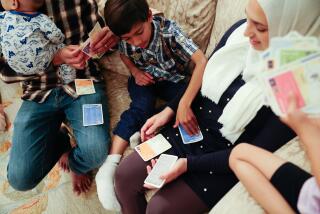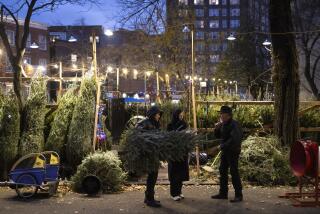Colonial Style : Williamsburg Clings to Its Yuletide Ways
WILLIAMSBURG, Va. — When Janet Kimbrough’s grandmother lived here as a child nearly 150 years ago, the Christmas tree was a holiday tradition whose time had yet to come to America.
But in 1842, Dr. Charles Minnigerode, a political exile from Germany who was teaching at William and Mary College, followed German tradition and decorated an evergreen. In the years since, legend has held that it was perhaps the first Christmas tree in the country.
To this day, no one knows for certain. But as Kimbrough, an 84-year-old retired doctor, recounts the story, she notes with a twinkle in her eye that it was at least “the first tree in this neighborhood.”
Part of Folklore
Even so, the tale is part of the Christmas folklore of this small Tidewater city of 10,000 where, to this day, some of the nation’s oldest holiday traditions are meticulously preserved. And few know them as well as Kimbrough, a descendant of one of the leading Colonial families who lives in the house where her ancestors moved nearly 200 years ago.
Sitting in her rambling home recently as dusk deepened into night, Kimbrough waited for a cannon salvo to rip through the air, signaling residents to light nearly 1,500 white candles simultaneously in the windows of their homes and shops.
The night of this “grand illumination”--which also includes fireworks, blazing bonfires and the music of fifes and drums, balladeers and madrigal singers--officially ushers in a fortnight of holiday festivities in the immaculately restored historic area of Colonial Williamsburg. Each year more than 20,000 people, quaffing some 600 gallons of hot apple cider, observe the event.
Candles Are Electric
And although certain concessions are made to modern times--in conformance with fire safety laws, the illuminated candles are electric--the celebration largely reflects another side to Colonial Williamsburg, where tour buses bring nearly 2 million visitors a year.
For the people who call Colonial Williamsburg their home and for those whose destinies have been shaped by the crafts they have learned here, life in this Colonial capital seems far from the hectic pace of contemporary urban centers--and as far away from the holiday cacophony of cash registers and car horns as the North Pole.
“Someone complained to me that there was no night life here but there’s very little to attract rowdy types of groups,” Kimbrough observed.
Still, Christmas in Williamsburg is a far cry from the Spartan traditions of Colonial America, when there was no Santa Claus with a reindeer-drawn sleigh, no gift giving, no tinsel or lavish decorations. At one point in the 18th Century, the Massachusetts Bay Colony even declared observation of Christmas illegal and set a 5-shilling fine for those who stopped work to celebrate.
In addition, the holidays in the 18th and early 19th centuries were a deeply religious time mixed with fellowship. In Virginia, muskets or “Christmas guns” were fired to send holiday greetings between plantations. Tables, or groaning boards, were laden with roast beef, venison, Virginia ham, wild fowl, oysters and fish, plum puddings and mincemeat pies. And it was all washed down with beer, ale, cider and Madeira wine, perhaps a toddy or rum punch.
Natural Decorations
Festivities at that time focused on the home, where people often decorated simply with the natural bounty of their gardens.
Even now, during the holiday season, few people in Colonial Williamsburg are busier than flower decoration supervisor Libbey Hodges Oliver, who has worked here 12 years. Using only natural items available in the 18th Century, Oliver and her staff make all of the decorations for about 50 historic buildings.
The makers of wreaths and other door decorations have become world-famous for their skillful use of fresh fruit, including apples, lemons, pineapples, kumquats, pomegranates and artichokes; magnolia leaves, mistletoe and boxwood, and more exotic items such as yellow chinaberries, dried yarrow, okra and milkweed pods.
Residents and visitors are not the only ones who enjoy the decorations, however: each day, Oliver rides her bicycle through the area, carrying a basket with fresh fruit to replace pieces eaten by hungry birds.
And already, preparations are under way for Christmas, 1987, Oliver said. “We have meetings now going on for next year,” she said.
Year-Round Spirit
Others for whom Williamsburg has become a way of life help to keep the Christmas spirit year-round. One craftsman, James A. Curtis, 47, abandoned a college music career 25 years ago and has become one of the nation’s premier silversmiths.
“I don’t know of any other place in this country where all of the silver is made completely by hand,” he says. Each silver piece begins with small pellets called casting grains that are melted, cast into ingots and then hammered and polished into a pitcher or goblet.
“It’s very rewarding,” Curtis says of his work, which he explains painstakingly to visitors. “If I was in the modern world, I could never do this.”
Curtis now has custom orders for four complete silver coffee service sets--each priced at $30,314. But it may be just as well that they are not intended as Christmas gifts: The last one will not be completed until 1988.
More to Read
Sign up for Essential California
The most important California stories and recommendations in your inbox every morning.
You may occasionally receive promotional content from the Los Angeles Times.










